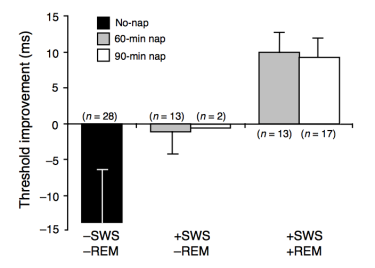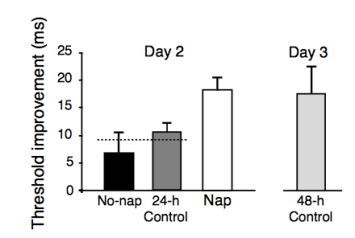Mednick, S., Nakayama, K., & Stickgold, R. (2003). Sleep-dependent learning: a nap is as good as a night. Nature neuroscience, 6(7), 697.
Review
Is getting enough sleep really that important? According to the CDC, 1 and 3 Americans are not sleeping as much as they should be every night. For quite some time, the function of sleep has eluded us. This, perhaps, has led us to disregard its benefits and continue with a life of sleep deprivation. However, in the past 20 years, research has made astounding progress in understanding what exactly sleep does for our body and mind. Recent findings especially have highlighted sleep’s importance and what we can do to circumvent the sleepless side effects of the typical busy American life.
A study published back in 2003 by Dr. Sara Mednick entitled, Sleep-dependent learning: a nap is as good as a night, examines one particular aspect of sleep known as memory consolidation. Research has shown that sleep not only repairs our body but also replenishes the mind though a serious of neural processes that keep us sharp and alert during the day. Memory consolidation is but one of these many neural functions, and operates by solidifying daily acquired skills and memories into long-term storage. You can think of this process as analogous to storing files on your computer’s hard drive or installing new software that requires a reboot after completion. Similarly, the human brain also requires a “reboot” to utilize new learning to its maximum efficiency.
Visual learning and sleep
Dr. Mednick and colleagues employed their investigation of sleep dependent memory consolidation in the field of “perceptual learning,” a variation in vision science that focuses on how our visual system learns new information in the environment. Perceptual learning has been widely studied for decades and acts as a powerful tool in testing brain plasticity due to how well we now understand the visual system and its functions. In the present study, Mednick tested over 70 healthy participants on a standard perceptual learning task, referred to as a Texture Discrimination Task (TDT), and assessed how naps affected performance trends.
The experiment consisted of three groups. The first group was asked to arrive at the Harvard sleep lab at 9:00am, where they were then asked to complete roughly an hour of training on the TDT. Their data over that hour was collected and fitted to a psychometric function allowing the researchers to determine a “threshold” in performance, which specified the hardest difficulty level on the TDT that the participants could still keep 80% accuracy. The first group of participants was then asked to come back to the lab at 7:00pm that evening to complete a short “re-test” to measure performance changes and then again that following morning at 9am. The schedule for the second and third groups was identical to the first, except that they were asked to come back to the lab at 2pm to take a nap for either 60 minutes or 90 minutes, respectively. While seeping, the researchers monitored the participants’ brainwaves on a monitor with an electroencephalogram (EEG). In sum, the experiment investigated TDT performance changes over a 24-hour period with a no-sleep control group, as well as with 60-minute and 90-minute nap experimental groups.
Stages of sleep
One of the major benefits of this design plays on the fact that sleep is naturally broken up into various stages over an average of 90 minutes. While the exact values are different for everyone, your body cycles between four stages every 90 minutes that occur roughly 5 times over a typical night’s sleep. In each cycle, the body first enters light sleep known as Stage 1 sleep, where it is easiest to be disturbed and woken up. Stage 2 sleep then follows, and marks the beginning of deeper sleep, lasting approximately 20-30 minutes in duration. After, the body enters Stage 3 sleep, known as Slow Wave Sleep (SWS), which is marked by giant, synchronous delta brainwaves that can be seen on an EEG. SWS is considered to be the deepest part of sleep, even though the following stage, known as Rapid Eye Movement (REM) sleep, is thought to carry extreme significance for memory consolidation functions. By examining perceptual learning in the presence of naps, Mednick and colleagues were able to parse out subgroups that showed just SWS or both SWS and REM within the napping participants.

The results of Mednick’s study were quite novel, revealing unique trends in TDT performance associated with various sleep stages. The research team found that the groups that were able to experience both SWS and REM sleep during their naps had the largest improvement on the TDT. Interestingly, these same participants displayed even greater improvement when tested the following morning, far out-classing their SWS-only and non-nap counterparts. The SWS-only groups showed consistent performance on the TDT when re-tested at 7:00pm and only showed improvement the following day. This is similar to the no-nap group, except they actually performed worse on their 7:00pm re-test compared to the initial training, suggesting that the visual skills acquired were deteriorating without the memory-solidifying presence of sleep.
Control groups were employed both 24 hours and 48 hours after the initial training on the TDT, showing similar tends to the group that was able to achieve REM sleep in addition to SWS during their nap. The research team concluded that one full nap containing both SWS and REM sleep was sufficient to cause plastic changes in the brain that allowed for improvement on the TDT. This improvement was not only significant, but was almost identical in magnitude to the performance changes seen over 24 and 48 hours. This magnitude of improvement was unforeseen, and opens up many possibilities for the benefits of regular naps.

Are naps all we need?
The present study seems to heavily suggest, as seen in the title, that naps are indeed as good as a night. While this is quite a stretch from the truth in the literal sense, the researchers at Harvard University demonstrated that one full cycle of sleep is highly beneficial to acquiring visual skills. They speculated that there is something unique to REM sleep that affects the consolidation process of TDT. One theory is, given that TDT is a “procedural skill,” which means that is in the same realm as learning to play an instrument or ride a bike, that REM sleep specifically deals with procedural memories and their subsequent consolidation. Other studies have found that certain stages of sleep may be specific to other kinds of skills and memories, such as explicit memory, where memorizing lists of information is the core goal.
One major complication with this research is the multitude of studies that seem to support opposing findings depending on the task or experimental design. Naps with perceptual learning has been covered in a limited fashion, but analogous learning experiments have been conducted using different modalities such as motor learning, which has been regarded in classical research as similar in characteristics to perceptual learning. These studies (conducted by Dr. Giulio Tononi and colleagues) illustrated a plethora of evidence that SWS is actually the key to performance improvement on various tasks. Other groups have reported that, rather than each individual stage, the relationship between SWS and REM sleep is what allows for successful consolidation.
Mednick’s study alone, does not resolve any of the above controversies, but instead offers a new perspective on studying sleep with their unique nap design. Should we substitute our debilitating daily fatigue with a nap rather than a full night of sleep? Probably not, but what we can take away is that a nap, especially one with a full sleep cycle, is never a bad idea.
